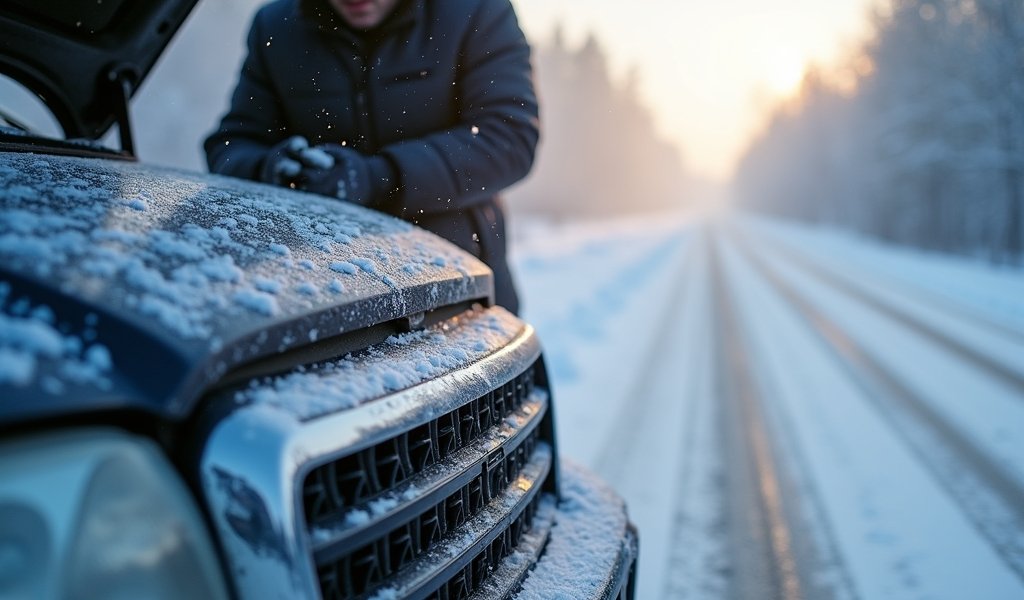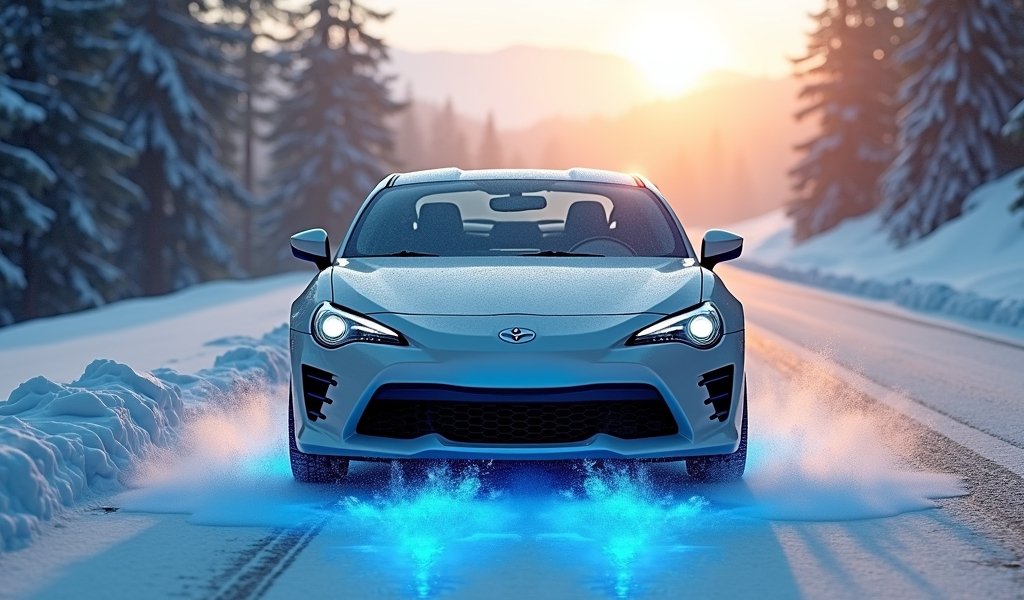Overview
This article provides detailed guidance on selecting and maintaining the proper antifreeze for winter driving conditions, explaining different types (IAT, OAT, HOAT), recommended brands, appropriate concentration ratios, and maintenance procedures. Beyond antifreeze, the article emphasizes the importance of comprehensive winter vehicle preparation, including checking other fluids, battery health, and carrying an emergency kit for cold weather safety.
Table of Contents
- Understanding Antifreeze: Your Car’s Winter Lifeline
- Types of Antifreeze: Colors, Chemicals, and Compatibility
- Top Antifreeze Brands for Winter Performance
- How to Choose the Right Antifreeze for Your Vehicle
- Proper Antifreeze Concentration for Winter Conditions
- Checking and Replacing Your Antifreeze
- Winter Emergency Preparedness: Beyond Antifreeze
- Common Antifreeze Myths Debunked
- Conclusion
- Frequently Asked Questions
Understanding Antifreeze: Your Car’s Winter Lifeline
When temperatures plummet and winter tightens its icy grip, the best antifreeze for winter driving becomes your vehicle’s first line of defense. As a mechanic with over 15 years of experience, I’ve seen firsthand what happens when this crucial fluid is neglected. Think of antifreeze (or coolant) as your engine’s personal thermostat—it prevents freezing in winter, overheating in summer, and fights corrosion year-round.
Antifreeze is a glycol-based liquid that lowers the freezing point of the water in your cooling system. Without it, the water would freeze and expand, potentially cracking your engine block or damaging other components—a repair that could set you back thousands. But antifreeze does more than just prevent freezing; it’s part of a complex system of essential car fluids that keeps your engine running at optimal temperature.
Modern antifreeze formulations also contain additives that protect against corrosion, lubricate water pumps, and prevent scale buildup. These additives break down over time, which is why regular coolant maintenance isn’t just recommended—it’s essential for your vehicle’s longevity, especially during harsh winter conditions.
Types of Antifreeze: Colors, Chemicals, and Compatibility
The rainbow of antifreeze colors on store shelves isn’t just for show. Each color typically represents a different chemical formulation designed for specific types of engines and cooling systems. Let’s break down the main types:
Inorganic Acid Technology (IAT) – Traditional Green Antifreeze
The old-school green stuff was the standard for decades. IAT contains silicates and phosphates that quickly form a protective layer on metal surfaces. It works well but requires replacement every 30,000 miles or 2 years. Most vehicles manufactured before 2000 were designed with this type in mind.
Organic Acid Technology (OAT) – Usually Orange, Red, or Dark Green
OAT coolants use organic acids instead of silicates and phosphates. They’re slower to form protective barriers but last much longer—typically 5 years or 150,000 miles. General Motors pioneered these with their Dex-Cool formulation, and they’re common in many modern vehicles.
Hybrid Organic Acid Technology (HOAT) – Yellow or Orange
HOAT combines the fast-acting protection of IAT with the longevity of OAT. These are often recommended for newer Ford, Chrysler, and European vehicles and typically last about 5 years or 150,000 miles.
Propylene Glycol – Various Colors
While ethylene glycol is the traditional base for most antifreeze, propylene glycol offers a less toxic alternative that’s safer for households with children and pets. It provides slightly less freeze protection but is more environmentally friendly according to EPA safer choice products.
The critical thing to remember is that mixing incompatible types can cause chemical reactions that reduce effectiveness and potentially damage your cooling system. Always consult your owner’s manual or ask a professional before switching types.

Top Antifreeze Brands for Winter Performance
After testing countless formulations in professional settings, I can confidently recommend several antifreeze brands that consistently perform well in winter conditions. These recommendations balance quality, protection level, and value:
Prestone Extended Life Antifreeze/Coolant
Prestone offers excellent all-around protection with their yellow formulation that’s compatible with all makes and models. Their extended life formula protects against freezing down to -34°F while providing corrosion protection for aluminum and all other engine metals. It’s my go-to recommendation for most drivers looking for a universal solution.
Valvoline Zerex G-05 Antifreeze/Coolant
This HOAT formulation is specifically designed for late-model Chrysler, Ford, and European vehicles. It provides outstanding protection in extreme cold, preventing freezing down to -34°F when used at a 50/50 mixture. I’ve found it particularly effective for vehicles that see regular use in below-zero temperatures.
Peak OET Extended Life Antifreeze/Coolant
Peak’s orange OAT coolant works exceptionally well for GM vehicles and offers protection down to -34°F. The extended life formula can last up to 150,000 miles, making it an economical choice despite its premium price point. For the coldest climates, this would be my top pick.
Zerex Asian Vehicle Antifreeze
For Honda, Toyota, and other Asian manufacturers, this blue formulation is specifically engineered to meet their unique cooling system requirements. It provides freeze protection to -34°F and helps prevent the silicon seal erosion sometimes seen when using incorrect coolant types in these vehicles.
While premium brands typically outperform budget options in extreme conditions, the most important factor isn’t necessarily the brand name—it’s choosing the correct type for your specific vehicle and maintaining the proper concentration for your climate.
How to Choose the Right Antifreeze for Your Vehicle
Selecting the best antifreeze for winter driving isn’t about grabbing whatever’s on sale. Your choice should be guided by several key considerations:
Consult Your Owner’s Manual
This is non-negotiable. Your vehicle manufacturer has specified exactly what type of coolant your engine needs. Using the wrong type can void warranties and cause serious damage over time. The manual will typically specify a coolant type, often by a manufacturer-specific name or standard.
Consider Your Climate
If you live in an area with extreme winters where temperatures regularly dip below -20°F, you might need a higher concentration of antifreeze to water, potentially up to a 60/40 mix (but never exceeding 70/30, as this actually reduces effectiveness). Standard 50/50 mixtures protect against freezing to about -34°F, which is sufficient for most North American winters.
Understand Compatibility Issues
If you’re topping off existing coolant, you need to know what’s already in your system. As mentioned earlier, mixing incompatible coolants can create gel-like substances that clog your cooling system and reduce heat transfer efficiency. If you’re unsure what’s in your system, consider a complete coolant flush before adding new antifreeze.
Evaluate Long-Term Value
Extended life formulations may cost more initially but can prove economical over time. A premium coolant that needs replacement every 5 years might be a better value than a budget option requiring replacement every 2 years, especially when you factor in labor costs.
When in doubt, consult with a trusted mechanic. They can provide guidance specific to your vehicle make, model, and the conditions in which you drive. This small investment in expertise can prevent costly cooling system repairs down the road.
Proper Antifreeze Concentration for Winter Conditions
Getting the antifreeze-to-water ratio right is crucial for winter protection. Too little antifreeze won’t provide adequate freeze protection, while too much can actually reduce cooling efficiency and freeze protection.
The Science Behind the Mix
Pure water freezes at 32°F (0°C), but it also conducts heat better than antifreeze. Pure antifreeze actually freezes at a higher temperature than a proper mixture with water. The ideal mixture harnesses water’s superior heat transfer properties while using antifreeze to lower the freezing point dramatically.
Standard Recommendations
For most winter conditions in North America, a 50/50 mix of antifreeze and distilled water provides protection down to approximately -34°F (-36°C). This ratio also protects against boiling up to about 265°F (129°C), providing year-round protection.
Adjusting for Extreme Cold
In regions with exceptionally harsh winters, a 60/40 ratio of antifreeze to water can provide protection to around -62°F (-52°C). However, this comes with a trade-off in cooling efficiency during warmer periods. Never exceed a 70/30 ratio, as this actually begins to raise the freezing point again.
Using Pre-Mixed vs. Mixing Your Own
Pre-mixed coolant offers convenience and eliminates the potential for mixing errors. If mixing your own, always use distilled water—tap water contains minerals that can cause deposits in your cooling system over time. A coolant hydrometer can help you verify your mixture’s freeze protection level.
Remember that a proper concentration isn’t just about freeze protection—it also ensures optimal corrosion protection. Coolant additives are designed to work at specific concentrations, and diluting them too much reduces their effectiveness at fighting corrosion throughout your cooling system.

Checking and Replacing Your Antifreeze
Regular maintenance ensures your antifreeze performs when you need it most. Here’s how to properly check and replace your coolant before winter arrives:
How to Check Your Antifreeze
- Only check coolant when the engine is cool to avoid burns from pressurized hot coolant
- Locate the coolant reservoir (translucent plastic container, usually marked “coolant”)
- Verify the fluid level is between the “min” and “max” lines
- Inspect the color—cloudy or rusty coolant indicates contamination
- Test protection level using an antifreeze tester (available at any auto parts store)
For a more thorough evaluation, check the pH level with test strips. Most antifreeze should have a pH between 8.5-11. As coolant ages and additives deplete, the pH typically drops, indicating it’s time for replacement.
When to Replace Antifreeze
Even if your coolant looks clean, the protective additives break down over time. For traditional green antifreeze (IAT), replace every 2 years or 30,000 miles. Extended life formulations (OAT, HOAT) typically last 5 years or 100,000-150,000 miles, but these are maximum intervals—not guarantees.
If you’re approaching winter and haven’t changed your coolant in years, err on the side of caution with a fresh fill. The cost of new coolant is minimal compared to repairing a cracked engine block from freeze damage.
DIY Coolant Replacement Basics
While a full guide to flushing your coolant deserves its own article, here are the fundamental steps:
- Gather supplies: correct antifreeze, distilled water, drain pan, and flush kit if needed
- Ensure the engine is completely cool before beginning
- Locate and open the radiator drain petcock, collecting old coolant in a drain pan
- Consider using a flush solution to remove deposits if the system is old or contaminated
- Close the petcock and add the new antifreeze/water mixture
- Run the engine with the heater on to purge air pockets
- Check for leaks and top off as needed
Always dispose of used antifreeze properly—it’s toxic to humans and animals but can be recycled at most auto parts stores or local hazardous waste facilities.
Winter Emergency Preparedness: Beyond Antifreeze
While the best antifreeze for winter driving is essential, comprehensive winter car maintenance involves several other critical aspects. Even with perfect antifreeze protection, winter throws unique challenges at your vehicle that require preparation.
Essential Winter Fluids Check
Before the first freeze, verify all your vehicle’s fluids are winter-ready:
- Motor oil: Consider switching to a winter-grade oil with lower viscosity for cold starts
- Windshield washer fluid: Replace with a winter formula rated to at least -20°F
- Brake fluid: Check for contamination which can affect performance in extreme cold
- Power steering fluid: Ensure proper levels for optimal handling on icy roads
- Transmission fluid: Verify level and condition for smooth operation in cold temperatures
Battery and Electrical System
Cold weather significantly reduces battery performance—a battery that works fine in summer might fail on the first freezing morning. Have your battery professionally load-tested before winter, especially if it’s over three years old. Clean any corrosion from terminals and ensure connections are tight.
Winter Emergency Kit
Even with perfect maintenance, winter emergencies happen. Keep these items in your vehicle:
- Jumper cables or portable jump starter
- Small container of spare antifreeze/coolant
- Ice scraper and snow brush
- Shovel and traction aids (sand, cat litter, or traction mats)
- Blankets and extra warm clothing
- Flashlight with fresh batteries
- Non-perishable food and water
- First aid kit
Research from NHTSA winter driving guidelines shows that proper preparation significantly reduces your risk of becoming stranded in dangerous winter conditions. A small investment in emergency supplies can be life-saving when temperatures plummet.
Common Antifreeze Myths Debunked
After years in the shop, I’ve heard plenty of misconceptions about antifreeze. Let’s separate fact from fiction:
Myth: All Antifreeze Is Basically the Same
This couldn’t be further from the truth. Different formulations contain specific corrosion inhibitors designed for particular metals and cooling system components. Using the wrong type can accelerate corrosion and lead to cooling system failure. Always use the type specified by your vehicle manufacturer.
Myth: You Can Mix Different Colors of Antifreeze
While color isn’t a guaranteed indicator of chemical composition, different colored coolants typically have different chemical formulations. Mixing incompatible types can cause additives to precipitate out, forming a gel-like substance that can clog your cooling system and reduce heat transfer efficiency.
Myth: Pure Antifreeze Provides Better Winter Protection
Counterintuitively, using 100% antifreeze without water actually reduces freeze protection. The optimal freeze protection comes from a proper mixture with water, usually 50/50 or 60/40 for extreme conditions. Pure antifreeze also reduces cooling efficiency since water transfers heat better.
Myth: Antifreeze Lasts Indefinitely
Even sealed antifreeze has a shelf life. Over time, the corrosion inhibitors and other additives break down, reducing effectiveness. Open containers absorb moisture from the air, diluting the concentration. For best results, use antifreeze within one year of opening and check the expiration date on sealed containers.
Myth: Green Antifreeze Is Always IAT and Orange Is Always OAT
While traditionally true, today’s market includes coolants where color doesn’t reliably indicate chemical composition. Some manufacturers now use traditional colors for different formulations. The only way to be certain is to read the label and specifications rather than relying solely on color.
Understanding these realities rather than perpetuating myths will help you make informed decisions about your vehicle’s cooling system maintenance, especially when preparing for challenging winter conditions.
Conclusion
Selecting the best antifreeze for winter driving isn’t just about preventing a frozen engine—it’s about ensuring your vehicle’s reliability during the most challenging driving conditions of the year. The right antifreeze, properly maintained and at the correct concentration, protects your engine from freezing, corrosion, and premature wear.
Remember that antifreeze is a critical component of your vehicle’s health, but it’s just one part of comprehensive winter preparation. Regular checks of all fluids, the battery, tires, and carrying emergency supplies complete your winter driving safety strategy.
As temperatures drop, take the time to verify your antifreeze protection level and type. This small investment of time can prevent costly repairs and potentially dangerous breakdowns when the mercury plummets. Your vehicle’s cooling system is its lifeline in winter—treat it with the attention it deserves.
Whether you’re topping off your coolant or performing a complete flush, always follow manufacturer recommendations and use the correct type for your specific vehicle. When in doubt, consult a professional mechanic who can help ensure your cooling system is ready to face whatever winter brings.
Frequently Asked Questions
Can I mix different colors of antifreeze?
No, mixing different antifreeze colors is not recommended. Different colors typically indicate different chemical formulations that may react negatively when combined.
How often should antifreeze be replaced for winter driving?
Traditional (IAT) antifreeze should be replaced every 2 years or 30,000 miles. Extended life formulations (OAT/HOAT) typically last 5 years or 100,000-150,000 miles.
What’s the best antifreeze-to-water ratio for extreme cold?
For extreme cold below -34°F, a 60/40 antifreeze-to-water ratio provides better protection. Never exceed 70/30 as this actually reduces freeze protection.
Is premium antifreeze worth the extra cost for winter driving?
Premium antifreeze often contains better corrosion inhibitors and may last longer. The additional protection is typically worth the modest price difference, especially in severe winter conditions.
Can I use water instead of antifreeze in an emergency?
Water alone should only be used in absolute emergencies and replaced with proper coolant immediately. Water will freeze at 32°F and offers no corrosion protection or lubrication for your water pump.

